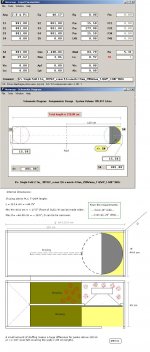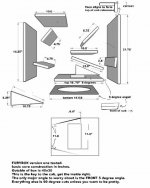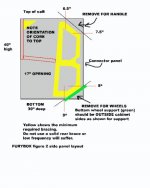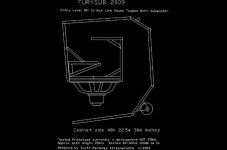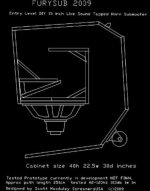Hi all.
I'm still alive but its been a very hard road..... I'm going to go karaoke as it seems the only niche here worth pursuing.
I still have the first set of fury subs but do not have the ability to move them.
I'll be running up to 4 Peavey pr15, modded of course .
.
I upgraded the horns to 22xt and lines the cabs with auralex... nice and clear now.
Need to re house my 3015's to fit in an suv without a wood shop to work in.
I was looking for something simple like the Bjorno sub, and also want to find the latest ss15 for the archive. The Furys will go to storage till I have a van.
Looking to enhance below 80, preferably with a bump in the 40-60 range.
JBELL: Nice to see to extended the ss15 and dealt with the compression or
cone protectiom in an elequent manner. Very nice.
Welter, Tb46, and others... hi yall, glad your still kicking.
Cheers
I'm still alive but its been a very hard road..... I'm going to go karaoke as it seems the only niche here worth pursuing.
I still have the first set of fury subs but do not have the ability to move them.
I'll be running up to 4 Peavey pr15, modded of course
I upgraded the horns to 22xt and lines the cabs with auralex... nice and clear now.
Need to re house my 3015's to fit in an suv without a wood shop to work in.
I was looking for something simple like the Bjorno sub, and also want to find the latest ss15 for the archive. The Furys will go to storage till I have a van.
Looking to enhance below 80, preferably with a bump in the 40-60 range.
JBELL: Nice to see to extended the ss15 and dealt with the compression or
cone protectiom in an elequent manner. Very nice.
Welter, Tb46, and others... hi yall, glad your still kicking.
Cheers
I'll make an offer that I think I've made before - I can host these DIY designs on my diysubwoofers.org site at no cost, and the site itself is not going to disappear any time soon. All I need are the basics, e.g. dimensions, build instructions, driver information, sims and preferably measured impedance curves and SPL response, and finally perhaps a short note from the designer about his design.
Hi screamersusa,
Good to see that you're still at it. I found one of bjorno's 3015Lf simulations, haven't found the thread yet; this should be an easy build. Haven't seen an updated SS15, I think that the original is still as good as it gets for that driver, and that range.
Regards,
Good to see that you're still at it. I found one of bjorno's 3015Lf simulations, haven't found the thread yet; this should be an easy build. Haven't seen an updated SS15, I think that the original is still as good as it gets for that driver, and that range.
Regards,
Attachments
Hi sine143,
For the fury box see Post #535 here: http://www.diyaudio.com/forums/subwoofers/131852-live-sound-specific-tapped-horn-thread-54.html , also take a look at the surrounding discussion. I'll attach the drawings I have from Screamersusa's website.
Regards,
For the fury box see Post #535 here: http://www.diyaudio.com/forums/subwoofers/131852-live-sound-specific-tapped-horn-thread-54.html , also take a look at the surrounding discussion. I'll attach the drawings I have from Screamersusa's website.
Regards,
Attachments
I have the dimensions for the 2009 version of the Fury Subwoofer if anyone's interested. They do take a bit of deciphering, it's not a step by step build instruction. I'm not sure if there have been any updates since then.
Attachments
Last edited:
Hi TimLewis,
Yes, the pdf in Post #7 is what I referred to in Post #6, please, take a look around at the preceding and following pages if you want to build the FURYBOX. There never was a complete resolution as to some of the finer points, and screamersusa used up a lot of plywood to come up with this version.
Regards,
Yes, the pdf in Post #7 is what I referred to in Post #6, please, take a look around at the preceding and following pages if you want to build the FURYBOX. There never was a complete resolution as to some of the finer points, and screamersusa used up a lot of plywood to come up with this version.
Regards,
Thanks for finding those.....
I built the last 4 fury subs from the same drawings so that was as far as I got due to life's unexpected battering... The 6 served absurdly well for years and I still have 2. I HATED to give the other 4 away but there is no work here.
They even served up punishing low end for some major rock acts including one with Malmsteins drummer. Talk about double kick machine gun hell
Never blew one up other than a failed braid on a heavy magnet 4015. Eminence replaced the speaker even though I patched it.
I had figured by now someone would have tweaked the fury sub or the ss15 would have been improved to go closer to 40 with some spl loss.
The funniest thing was the look on many pros faces after asking where I had the "other" amp rack hidden and I replied, there isn't another one.
I can grab a 4507 jbl box, would it be easier to just re port it for a single 3015lf for now?
I built the last 4 fury subs from the same drawings so that was as far as I got due to life's unexpected battering... The 6 served absurdly well for years and I still have 2. I HATED to give the other 4 away but there is no work here.
They even served up punishing low end for some major rock acts including one with Malmsteins drummer. Talk about double kick machine gun hell
Never blew one up other than a failed braid on a heavy magnet 4015. Eminence replaced the speaker even though I patched it.
I had figured by now someone would have tweaked the fury sub or the ss15 would have been improved to go closer to 40 with some spl loss.
The funniest thing was the look on many pros faces after asking where I had the "other" amp rack hidden and I replied, there isn't another one.
I can grab a 4507 jbl box, would it be easier to just re port it for a single 3015lf for now?
A couple of quick notes on the furysub.
The furysub benefited from two discoveries discovered while building its impossible to recreate predecessor, the CH1524.
The first was the use of fluid dynamics modeling to tweak the angles as best as possible. I used a demo of a plumbing and air conditioning flow software to get a feel for how air under pressure might react inside the cab.
The second was the discovery that it takes trial and error to get it right because Tone is subjective. Flat on paper may not sound very good in real life. I Learned that Speaker building is an art just like making violins or guitars.
The furysub's intent was to recreate that angry authoritative tone only achieved by 8 stacks of double 18's in a concert hall but in a club size.
It was intentionally not designed to be perfectly flat response.
I wanted a sub that enhanced 40-60 enough so that I could cut said frequencies instead of boosting them as most people do.
They do that very well and fit a standard pro sound truck pack.
If your wood is clean, use Nashua 328 (the thick one) ac duct sealing tape on all the seams you can. The adhesive is killer!!! Still holding in my cabs.
That stuff can also save your butt if you have an air leak you can reach.
DO NOT change those odd angled reflectors to symetrical 45 degree types.
You will see big dips in the response if you do. These will drastically effect the Tone of the cab. They dont have to be perfect but the must not be symetrical. It's human nature to make things appear even
The key to amazing sounding wood paneled world class studios is uneven walls to inhibit standing waves. Same trick here applies within reason.
Lastly... you really have to get used to the sound of tapped horns. The distortion made by direct radiators or normal horns simply is not there. They make your low end sound more like studio monitors but LOUDER!!!
They also shake buildings when used outside like those boom boom rap music cars do when they pass by! Please keep that in mind
if your doing a rave or something and pay attention to the structure you are working in as you can potentially cause a very nasty
"accident". Feel the walls, look at the ceiling, go outside etc. I've knocked stuff off bar walls, blown out ceiling tiles, and made going to the toilet a rather "shaky" experience. The cabs can be pointed away from troublesome walls like the back of a kitchen.
For small areas, use them on their side,magnets facing center of dance area etc. For long areas use them upright.
The furysub benefited from two discoveries discovered while building its impossible to recreate predecessor, the CH1524.
The first was the use of fluid dynamics modeling to tweak the angles as best as possible. I used a demo of a plumbing and air conditioning flow software to get a feel for how air under pressure might react inside the cab.
The second was the discovery that it takes trial and error to get it right because Tone is subjective. Flat on paper may not sound very good in real life. I Learned that Speaker building is an art just like making violins or guitars.
The furysub's intent was to recreate that angry authoritative tone only achieved by 8 stacks of double 18's in a concert hall but in a club size.
It was intentionally not designed to be perfectly flat response.
I wanted a sub that enhanced 40-60 enough so that I could cut said frequencies instead of boosting them as most people do.
They do that very well and fit a standard pro sound truck pack.
If your wood is clean, use Nashua 328 (the thick one) ac duct sealing tape on all the seams you can. The adhesive is killer!!! Still holding in my cabs.
That stuff can also save your butt if you have an air leak you can reach.
DO NOT change those odd angled reflectors to symetrical 45 degree types.
You will see big dips in the response if you do. These will drastically effect the Tone of the cab. They dont have to be perfect but the must not be symetrical. It's human nature to make things appear even
The key to amazing sounding wood paneled world class studios is uneven walls to inhibit standing waves. Same trick here applies within reason.
Lastly... you really have to get used to the sound of tapped horns. The distortion made by direct radiators or normal horns simply is not there. They make your low end sound more like studio monitors but LOUDER!!!
They also shake buildings when used outside like those boom boom rap music cars do when they pass by! Please keep that in mind
if your doing a rave or something and pay attention to the structure you are working in as you can potentially cause a very nasty
"accident". Feel the walls, look at the ceiling, go outside etc. I've knocked stuff off bar walls, blown out ceiling tiles, and made going to the toilet a rather "shaky" experience. The cabs can be pointed away from troublesome walls like the back of a kitchen.
For small areas, use them on their side,magnets facing center of dance area etc. For long areas use them upright.
Last edited:
Screamersusa,If your wood is clean, use Nashua 328 (the thick one) ac duct sealing tape on all the seams you can.
The distortion made by direct radiators or normal horns simply is not there.
Some guys would prefer to use paintable caulk rather than duct tape for sealing seam leaks in plywood cabinets.
As far as distortion, TH can have around 6 dB more output for a given excursion, but distortion is higher at a given excursion than the same driver used in bass reflex cabinets, especially when using light cones like the Eminence 3015LF or 4015LF. Jbel once showed an RTA screen of the SS15 driven with a sine wave showing the second harmonic SPL well above the fundamental tone, distortion in excess of 100% at what you used to refer to as "war" volume
Due to the two impedance and excursion minima points in the passband, TH distortion does have a different distribution than a BR, so they do have a different sound when driven hard than BR.
Art
Screamsusa, thanks for showing up here after a long hiatus. While you are at this thread, just try giving some more input on your Furysub build in order to get some more details on that beautiful pdf rendering. It is one of the best services you can render to the diyaudio community and the Furysub can live on. Thanks again.
As far as distortion, TH can have around 6 dB more output for a given excursion, but distortion is higher at a given excursion than the same driver used in bass reflex cabinets, especially when using light cones like the Eminence 3015LF or 4015LF.
How do the distortion characteristics compare when the TH and BR are played at the same voltage input level? What about at the same output level in the passband, or at specific frequencies within the passband?
How many drivers were testing in THs and corresponding BR boxes to support this general conclusion?
Jbel once showed an RTA screen of the SS15 driven with a sine wave showing the second harmonic SPL well above the fundamental tone, distortion in excess of 100% at what you used to refer to as "war" volume.
What frequency was this test tone, and was it inside or outside of the TH's passband?
Brian,1)How do the distortion characteristics compare when the TH and BR are played at the same voltage input level? What about at the same output level in the passband, or at specific frequencies within the passband?
2)How many drivers were testing in THs and corresponding BR boxes to support this general conclusion?
3)What frequency was this test tone, and was it inside or outside of the TH's passband?
1) You can see distortion characteristics comparisons between TH and BR at the same voltage input level using B&C18SW115-4 in this thread:
http://www.diyaudio.com/forums/subwoofers/185588-keystone-sub-using-18-15-12-inch-speakers.html
2) I have also done comparisons between Lab 12 in TH and BR, the same general distortion results held true. The lighter coned Eminence 4015LF was so obviously distorted when run near Xmax in the Keystone sub I did not bother doing distortion testing, but in a BR it has very respectably low distortion.
3) I don't remember exactly, though I think it was around 45 Hz, just a bit below the pass band.It was in a thread that was severely moderated, and my reference to the post # became screwed up, never found it again, and Jbell never posted any distortion results again after, AFAIK.
Art
1) You can see distortion characteristics comparisons between TH and BR at the same voltage input level using B&C18SW115-4 in this thread:
http://www.diyaudio.com/forums/subwoofers/185588-keystone-sub-using-18-15-12-inch-speakers.html
2) I have also done comparisons between Lab 12 in TH and BR, the same general distortion results held true. The lighter coned Eminence 4015LF was so obviously distorted when run near Xmax in the Keystone sub I did not bother doing distortion testing, but in a BR it has very respectably low distortion.
Ok, it looks like the distortion tests were done with the same input level. I think it's worth noting that at the same input level your THs had significantly more output than the BR tested. Did you do any distortion testing with the boxes at same (or nearly the same output level), say at Fb?
3) I don't remember exactly, though I think it was around 45 Hz, just a bit below the pass band.It was in a thread that was severely moderated, and my reference to the post # became screwed up, never found it again, and Jbell never posted any distortion results again after, AFAIK.
I'd be interested in not only if it was outside the passband, but the voltage level as well. Like a BR, THs are unloaded below the passband, and depending on the alignment, they can unload quite quickly too.
Pardon my ignorance... seriously...
I was thinking about distortion today....
It might be worth mentioning that I marked my cones with silver marker slightly below xmax. My limiters were set to keep the output to the subs at or below that. After a while you learn how to push em by rolling the hpf upwards as volume increases. Perhaps thats why they never seemed distorted like the average double 18. Tapped horns do appear to audibly break up way past the point that double 18's do, then it's probably too late anyway.
The reason you see so many double 18 bins at big shows is to attempt to keep them below xmax. 15's are faster too, different sound, more articulate.
I've seen other guys use masking tape as well.
I play with different types of caulk every day at work.... dont really trust it if I cant get at it to replace it later.
The nashua I refer to is the thick aluminum tape, used as a second layer over your hopefully air tight seam. The glue is quite good and the product is quite forgiving to work with. Held up fine for years so far while the cabs were
beaten to hell 4x a week for 8+ hours a night in the florida humidity.
I just remembered I also used the dynamic eq in the behringer ultra drive xover, as level went up I rolled the low end off along with
4k and a couple of other painfull freqs. Took a while to set up right, but worth it.
I was thinking about distortion today....
It might be worth mentioning that I marked my cones with silver marker slightly below xmax. My limiters were set to keep the output to the subs at or below that. After a while you learn how to push em by rolling the hpf upwards as volume increases. Perhaps thats why they never seemed distorted like the average double 18. Tapped horns do appear to audibly break up way past the point that double 18's do, then it's probably too late anyway.
The reason you see so many double 18 bins at big shows is to attempt to keep them below xmax. 15's are faster too, different sound, more articulate.
I've seen other guys use masking tape as well.
I play with different types of caulk every day at work.... dont really trust it if I cant get at it to replace it later.
The nashua I refer to is the thick aluminum tape, used as a second layer over your hopefully air tight seam. The glue is quite good and the product is quite forgiving to work with. Held up fine for years so far while the cabs were
beaten to hell 4x a week for 8+ hours a night in the florida humidity.
I just remembered I also used the dynamic eq in the behringer ultra drive xover, as level went up I rolled the low end off along with
4k and a couple of other painfull freqs. Took a while to set up right, but worth it.
Last edited:
Exceeding Xmax isn't the only cause of distortion. Cone flex, asymmetrical BL curve, non-linear suspension can all contribute. Some of these distortion components can actually be amplified by the TH's design (i.e. any peaks in the TH's output will also amplify any distortion components that appear at those frequencies).
Nice idea to use the dynamic EQ to roll the low end off at high output levels. Peak excursion in a TH occurs around 1.4*the lower resonance frequency (let's call that Fb), so dynamic EQ at that frequency could work as well, and preserve some of the output capability between there and Fb.
Nice idea to use the dynamic EQ to roll the low end off at high output levels. Peak excursion in a TH occurs around 1.4*the lower resonance frequency (let's call that Fb), so dynamic EQ at that frequency could work as well, and preserve some of the output capability between there and Fb.
Brian,Ok, it looks like the distortion tests were done with the same input level. I think it's worth noting that at the same input level your THs had significantly more output than the BR tested. Did you do any distortion testing with the boxes at same (or nearly the same output level), say at Fb?
Right, as noted in post #12, TH can have around 6 dB more output for a given excursion, but distortion is higher at a given excursion than the same driver used in bass reflex cabinets, especially when using light cones like the Eminence 3015LF or 4015LF.
Since distortion increases in both TH or BR as drive levels (and excursion) increases, I generally test at full power level, since that ultimately is the level they will be used at, so no attempts were made to reduce power in the TH to match the BR level.
At Fb, the TH and BR using the BC18SW115-4 had similar distortion level, though port compression reduced the high level output compared to low level in the BR. Interestingly, the opposite occurs in the TH, upper level reduced at high level compared to low, another sonic difference apparent between low level and high level operation between TH and BR.
Art
Right, as noted in post #12, TH can have around 6 dB more output for a given excursion, but distortion is higher at a given excursion than the same driver used in bass reflex cabinets, especially when using light cones like the Eminence 3015LF or 4015LF.
This doesn't surprise me - those distortion components are likely being amplified by that same gain in overall output that the TH is providing. The enclosure doesn't care if its a copy of the original signal or a distortion component that's originating from the driver.
The question really here is if the distortion components are being increased by more or less than amount that the overall output has been increased in the designated pass band of the alignment. If less, then the TH can be said to be a lower-distortion alignment for a given driver.
At Fb, the TH and BR using the BC18SW115-4 had similar distortion level, though port compression reduced the high level output compared to low level in the BR. Interestingly, the opposite occurs in the TH, upper level reduced at high level compared to low, another sonic difference apparent between low level and high level operation between TH and BR.
If you're referring to continuous output, the TH's drop in upper frequency output at higher SPL levels could be due to the increase in Re (and therefore Qes) as the voice coil heats up. This can actually be sim'd in HornResp by upping Re under the Driver options in the Loudspeaker Wizard. There is some impact at low frequencies as well, but it's a lot less. Maybe it's best to build THs with a passband that gently slopes upwards to compensate response changes at higher SPL levels, rather than opting for a flat passband. Hmm... I'll consider that for POC #4
- Status
- This old topic is closed. If you want to reopen this topic, contact a moderator using the "Report Post" button.
- Home
- Loudspeakers
- Subwoofers
- 3015 latest ss15 and Bjorno sub plans needed
